HR Metrics and Analytics: Impact on Business Performance - Essay
VerifiedAdded on 2020/10/04
|8
|2496
|94
Essay
AI Summary
This essay provides a comprehensive overview of HR metrics and analytics, emphasizing their significance in evaluating and enhancing organizational performance. It defines HR metrics as standards for measuring HR performance and analytics as the application of data to reveal meaningful patterns. The essay outlines the use of database management systems in HR for managing employee data and payrolls. It explores various HR metrics related to recruitment, training, retention, and employee performance, such as time to hire, offer acceptance rates, training expenses per employee, and voluntary turnover rates. The essay highlights the link between HR metrics and financial performance, illustrating how these metrics can reduce costs, improve productivity, and increase profitability. It also discusses the components of a measurement plan, including defining key questions, metrics, and data sources. The document emphasizes the importance of HR metrics in making informed decisions about talent and driving organizational effectiveness. The essay concludes by underscoring the role of HR metrics in measuring and improving key areas of business, such as sales performance and customer service.
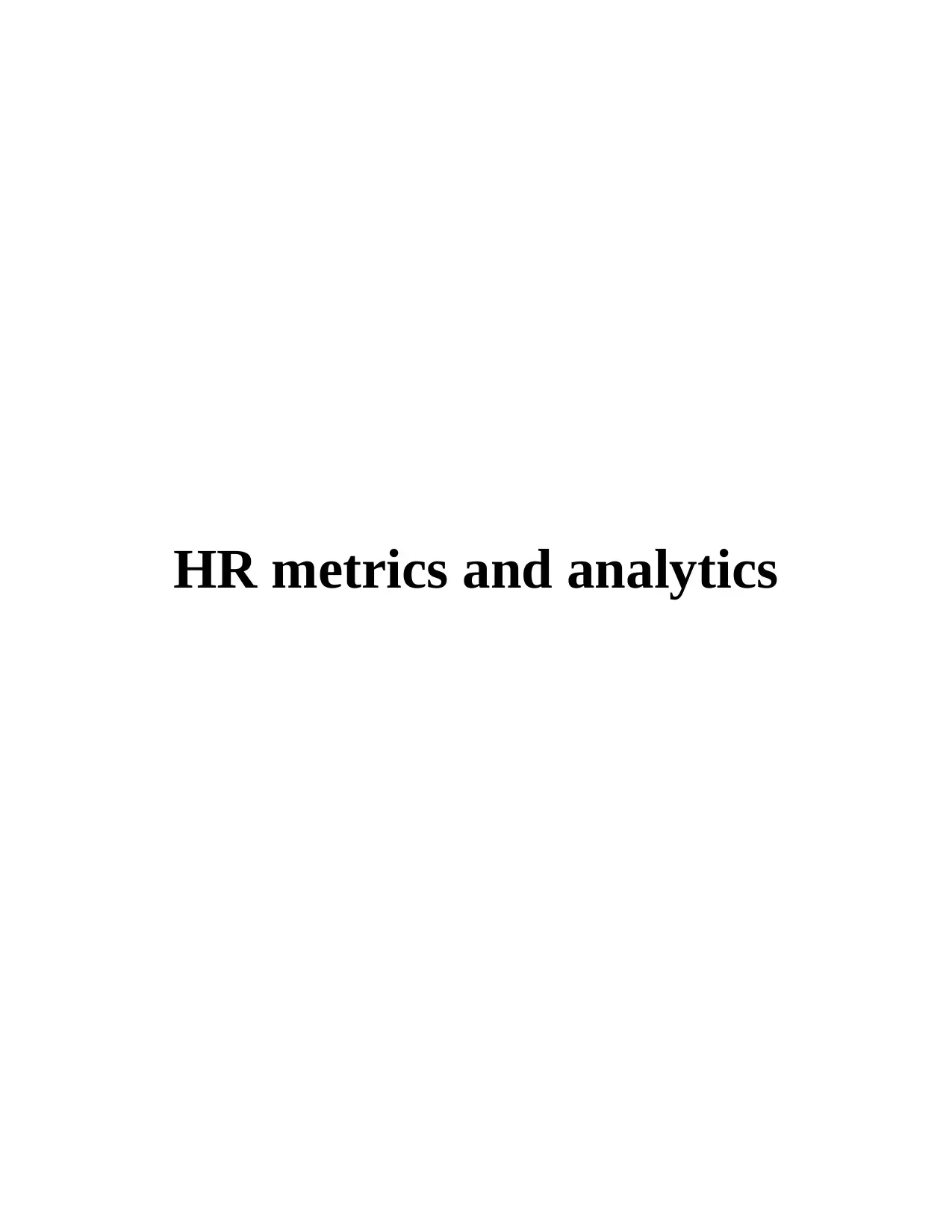
HR metrics and analytics
Paraphrase This Document
Need a fresh take? Get an instant paraphrase of this document with our AI Paraphraser

TABLE OF CONTENTS
Assessment 1....................................................................................................................................1
ESSAY.............................................................................................................................................1
REFERENCES................................................................................................................................5
Assessment 1....................................................................................................................................1
ESSAY.............................................................................................................................................1
REFERENCES................................................................................................................................5
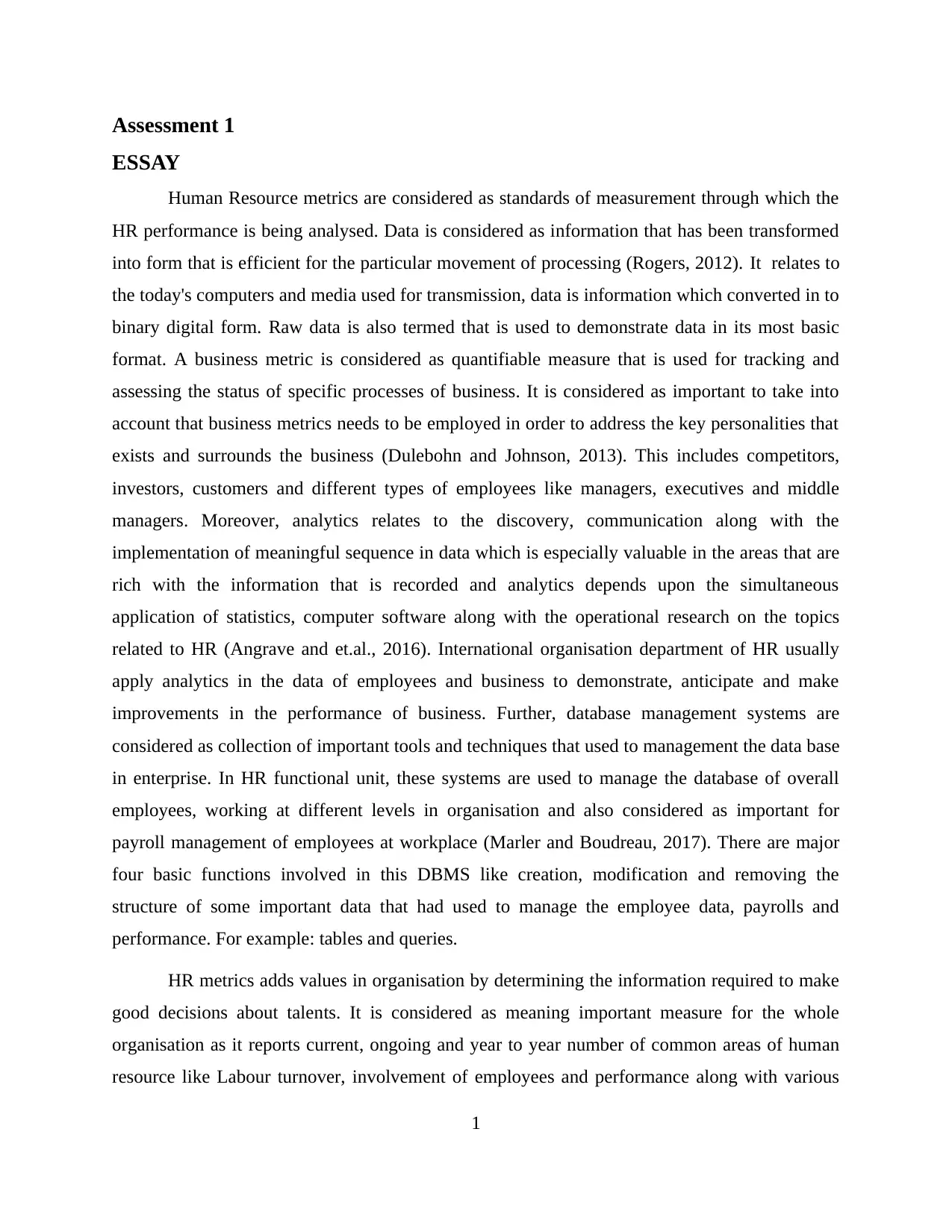
Assessment 1
ESSAY
Human Resource metrics are considered as standards of measurement through which the
HR performance is being analysed. Data is considered as information that has been transformed
into form that is efficient for the particular movement of processing (Rogers, 2012). It relates to
the today's computers and media used for transmission, data is information which converted in to
binary digital form. Raw data is also termed that is used to demonstrate data in its most basic
format. A business metric is considered as quantifiable measure that is used for tracking and
assessing the status of specific processes of business. It is considered as important to take into
account that business metrics needs to be employed in order to address the key personalities that
exists and surrounds the business (Dulebohn and Johnson, 2013). This includes competitors,
investors, customers and different types of employees like managers, executives and middle
managers. Moreover, analytics relates to the discovery, communication along with the
implementation of meaningful sequence in data which is especially valuable in the areas that are
rich with the information that is recorded and analytics depends upon the simultaneous
application of statistics, computer software along with the operational research on the topics
related to HR (Angrave and et.al., 2016). International organisation department of HR usually
apply analytics in the data of employees and business to demonstrate, anticipate and make
improvements in the performance of business. Further, database management systems are
considered as collection of important tools and techniques that used to management the data base
in enterprise. In HR functional unit, these systems are used to manage the database of overall
employees, working at different levels in organisation and also considered as important for
payroll management of employees at workplace (Marler and Boudreau, 2017). There are major
four basic functions involved in this DBMS like creation, modification and removing the
structure of some important data that had used to manage the employee data, payrolls and
performance. For example: tables and queries.
HR metrics adds values in organisation by determining the information required to make
good decisions about talents. It is considered as meaning important measure for the whole
organisation as it reports current, ongoing and year to year number of common areas of human
resource like Labour turnover, involvement of employees and performance along with various
1
ESSAY
Human Resource metrics are considered as standards of measurement through which the
HR performance is being analysed. Data is considered as information that has been transformed
into form that is efficient for the particular movement of processing (Rogers, 2012). It relates to
the today's computers and media used for transmission, data is information which converted in to
binary digital form. Raw data is also termed that is used to demonstrate data in its most basic
format. A business metric is considered as quantifiable measure that is used for tracking and
assessing the status of specific processes of business. It is considered as important to take into
account that business metrics needs to be employed in order to address the key personalities that
exists and surrounds the business (Dulebohn and Johnson, 2013). This includes competitors,
investors, customers and different types of employees like managers, executives and middle
managers. Moreover, analytics relates to the discovery, communication along with the
implementation of meaningful sequence in data which is especially valuable in the areas that are
rich with the information that is recorded and analytics depends upon the simultaneous
application of statistics, computer software along with the operational research on the topics
related to HR (Angrave and et.al., 2016). International organisation department of HR usually
apply analytics in the data of employees and business to demonstrate, anticipate and make
improvements in the performance of business. Further, database management systems are
considered as collection of important tools and techniques that used to management the data base
in enterprise. In HR functional unit, these systems are used to manage the database of overall
employees, working at different levels in organisation and also considered as important for
payroll management of employees at workplace (Marler and Boudreau, 2017). There are major
four basic functions involved in this DBMS like creation, modification and removing the
structure of some important data that had used to manage the employee data, payrolls and
performance. For example: tables and queries.
HR metrics adds values in organisation by determining the information required to make
good decisions about talents. It is considered as meaning important measure for the whole
organisation as it reports current, ongoing and year to year number of common areas of human
resource like Labour turnover, involvement of employees and performance along with various
1
⊘ This is a preview!⊘
Do you want full access?
Subscribe today to unlock all pages.

Trusted by 1+ million students worldwide
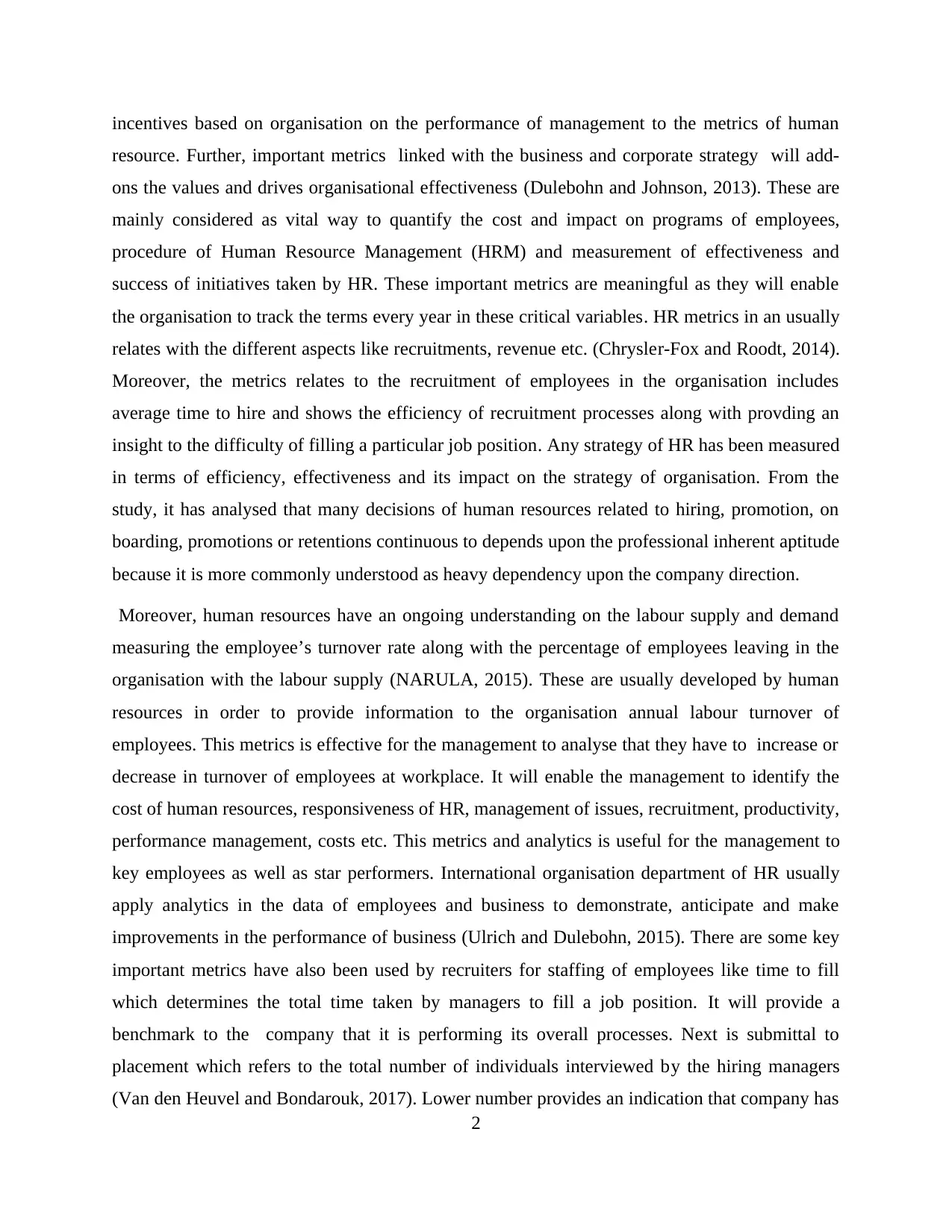
incentives based on organisation on the performance of management to the metrics of human
resource. Further, important metrics linked with the business and corporate strategy will add-
ons the values and drives organisational effectiveness (Dulebohn and Johnson, 2013). These are
mainly considered as vital way to quantify the cost and impact on programs of employees,
procedure of Human Resource Management (HRM) and measurement of effectiveness and
success of initiatives taken by HR. These important metrics are meaningful as they will enable
the organisation to track the terms every year in these critical variables. HR metrics in an usually
relates with the different aspects like recruitments, revenue etc. (Chrysler-Fox and Roodt, 2014).
Moreover, the metrics relates to the recruitment of employees in the organisation includes
average time to hire and shows the efficiency of recruitment processes along with provding an
insight to the difficulty of filling a particular job position. Any strategy of HR has been measured
in terms of efficiency, effectiveness and its impact on the strategy of organisation. From the
study, it has analysed that many decisions of human resources related to hiring, promotion, on
boarding, promotions or retentions continuous to depends upon the professional inherent aptitude
because it is more commonly understood as heavy dependency upon the company direction.
Moreover, human resources have an ongoing understanding on the labour supply and demand
measuring the employee’s turnover rate along with the percentage of employees leaving in the
organisation with the labour supply (NARULA, 2015). These are usually developed by human
resources in order to provide information to the organisation annual labour turnover of
employees. This metrics is effective for the management to analyse that they have to increase or
decrease in turnover of employees at workplace. It will enable the management to identify the
cost of human resources, responsiveness of HR, management of issues, recruitment, productivity,
performance management, costs etc. This metrics and analytics is useful for the management to
key employees as well as star performers. International organisation department of HR usually
apply analytics in the data of employees and business to demonstrate, anticipate and make
improvements in the performance of business (Ulrich and Dulebohn, 2015). There are some key
important metrics have also been used by recruiters for staffing of employees like time to fill
which determines the total time taken by managers to fill a job position. It will provide a
benchmark to the company that it is performing its overall processes. Next is submittal to
placement which refers to the total number of individuals interviewed by the hiring managers
(Van den Heuvel and Bondarouk, 2017). Lower number provides an indication that company has
2
resource. Further, important metrics linked with the business and corporate strategy will add-
ons the values and drives organisational effectiveness (Dulebohn and Johnson, 2013). These are
mainly considered as vital way to quantify the cost and impact on programs of employees,
procedure of Human Resource Management (HRM) and measurement of effectiveness and
success of initiatives taken by HR. These important metrics are meaningful as they will enable
the organisation to track the terms every year in these critical variables. HR metrics in an usually
relates with the different aspects like recruitments, revenue etc. (Chrysler-Fox and Roodt, 2014).
Moreover, the metrics relates to the recruitment of employees in the organisation includes
average time to hire and shows the efficiency of recruitment processes along with provding an
insight to the difficulty of filling a particular job position. Any strategy of HR has been measured
in terms of efficiency, effectiveness and its impact on the strategy of organisation. From the
study, it has analysed that many decisions of human resources related to hiring, promotion, on
boarding, promotions or retentions continuous to depends upon the professional inherent aptitude
because it is more commonly understood as heavy dependency upon the company direction.
Moreover, human resources have an ongoing understanding on the labour supply and demand
measuring the employee’s turnover rate along with the percentage of employees leaving in the
organisation with the labour supply (NARULA, 2015). These are usually developed by human
resources in order to provide information to the organisation annual labour turnover of
employees. This metrics is effective for the management to analyse that they have to increase or
decrease in turnover of employees at workplace. It will enable the management to identify the
cost of human resources, responsiveness of HR, management of issues, recruitment, productivity,
performance management, costs etc. This metrics and analytics is useful for the management to
key employees as well as star performers. International organisation department of HR usually
apply analytics in the data of employees and business to demonstrate, anticipate and make
improvements in the performance of business (Ulrich and Dulebohn, 2015). There are some key
important metrics have also been used by recruiters for staffing of employees like time to fill
which determines the total time taken by managers to fill a job position. It will provide a
benchmark to the company that it is performing its overall processes. Next is submittal to
placement which refers to the total number of individuals interviewed by the hiring managers
(Van den Heuvel and Bondarouk, 2017). Lower number provides an indication that company has
2
Paraphrase This Document
Need a fresh take? Get an instant paraphrase of this document with our AI Paraphraser
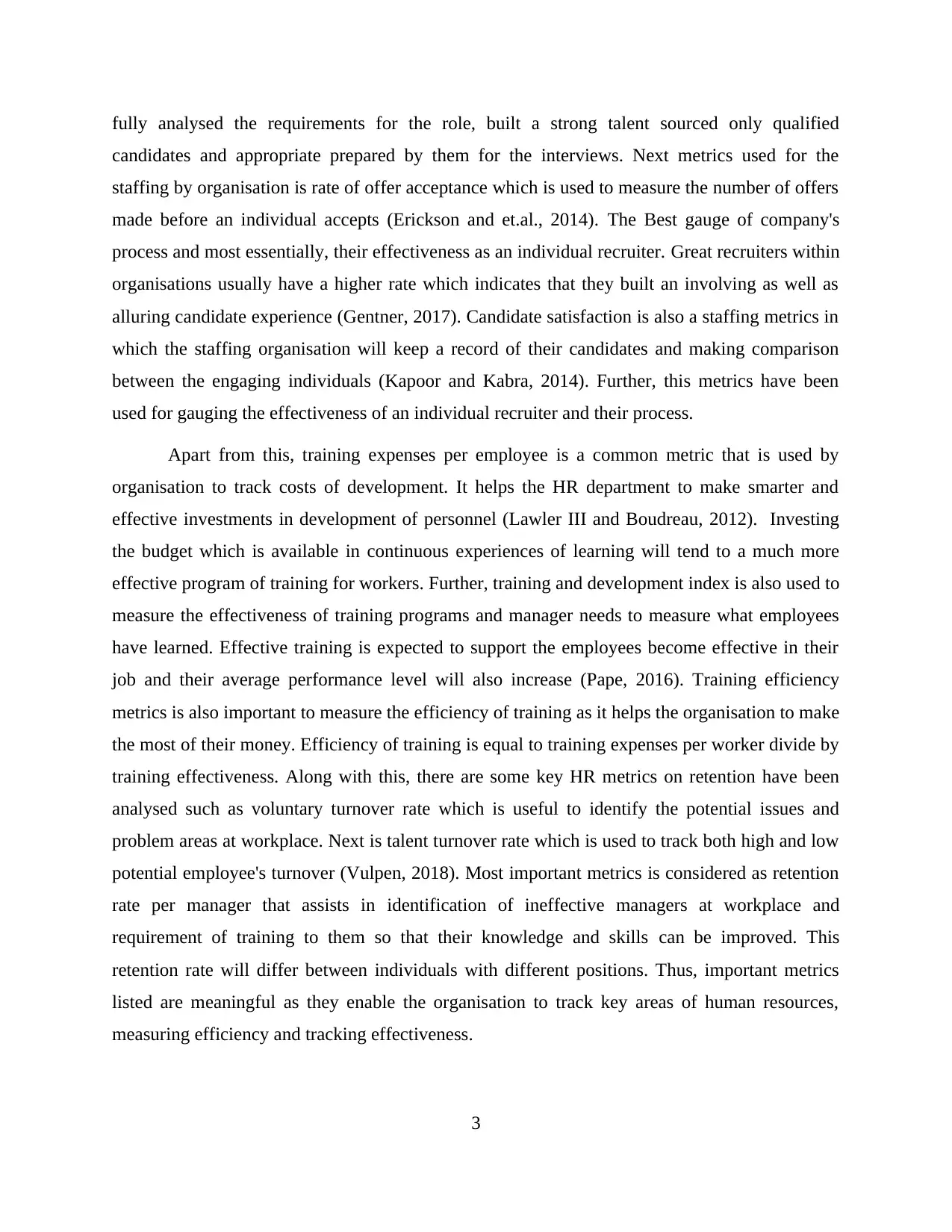
fully analysed the requirements for the role, built a strong talent sourced only qualified
candidates and appropriate prepared by them for the interviews. Next metrics used for the
staffing by organisation is rate of offer acceptance which is used to measure the number of offers
made before an individual accepts (Erickson and et.al., 2014). The Best gauge of company's
process and most essentially, their effectiveness as an individual recruiter. Great recruiters within
organisations usually have a higher rate which indicates that they built an involving as well as
alluring candidate experience (Gentner, 2017). Candidate satisfaction is also a staffing metrics in
which the staffing organisation will keep a record of their candidates and making comparison
between the engaging individuals (Kapoor and Kabra, 2014). Further, this metrics have been
used for gauging the effectiveness of an individual recruiter and their process.
Apart from this, training expenses per employee is a common metric that is used by
organisation to track costs of development. It helps the HR department to make smarter and
effective investments in development of personnel (Lawler III and Boudreau, 2012). Investing
the budget which is available in continuous experiences of learning will tend to a much more
effective program of training for workers. Further, training and development index is also used to
measure the effectiveness of training programs and manager needs to measure what employees
have learned. Effective training is expected to support the employees become effective in their
job and their average performance level will also increase (Pape, 2016). Training efficiency
metrics is also important to measure the efficiency of training as it helps the organisation to make
the most of their money. Efficiency of training is equal to training expenses per worker divide by
training effectiveness. Along with this, there are some key HR metrics on retention have been
analysed such as voluntary turnover rate which is useful to identify the potential issues and
problem areas at workplace. Next is talent turnover rate which is used to track both high and low
potential employee's turnover (Vulpen, 2018). Most important metrics is considered as retention
rate per manager that assists in identification of ineffective managers at workplace and
requirement of training to them so that their knowledge and skills can be improved. This
retention rate will differ between individuals with different positions. Thus, important metrics
listed are meaningful as they enable the organisation to track key areas of human resources,
measuring efficiency and tracking effectiveness.
3
candidates and appropriate prepared by them for the interviews. Next metrics used for the
staffing by organisation is rate of offer acceptance which is used to measure the number of offers
made before an individual accepts (Erickson and et.al., 2014). The Best gauge of company's
process and most essentially, their effectiveness as an individual recruiter. Great recruiters within
organisations usually have a higher rate which indicates that they built an involving as well as
alluring candidate experience (Gentner, 2017). Candidate satisfaction is also a staffing metrics in
which the staffing organisation will keep a record of their candidates and making comparison
between the engaging individuals (Kapoor and Kabra, 2014). Further, this metrics have been
used for gauging the effectiveness of an individual recruiter and their process.
Apart from this, training expenses per employee is a common metric that is used by
organisation to track costs of development. It helps the HR department to make smarter and
effective investments in development of personnel (Lawler III and Boudreau, 2012). Investing
the budget which is available in continuous experiences of learning will tend to a much more
effective program of training for workers. Further, training and development index is also used to
measure the effectiveness of training programs and manager needs to measure what employees
have learned. Effective training is expected to support the employees become effective in their
job and their average performance level will also increase (Pape, 2016). Training efficiency
metrics is also important to measure the efficiency of training as it helps the organisation to make
the most of their money. Efficiency of training is equal to training expenses per worker divide by
training effectiveness. Along with this, there are some key HR metrics on retention have been
analysed such as voluntary turnover rate which is useful to identify the potential issues and
problem areas at workplace. Next is talent turnover rate which is used to track both high and low
potential employee's turnover (Vulpen, 2018). Most important metrics is considered as retention
rate per manager that assists in identification of ineffective managers at workplace and
requirement of training to them so that their knowledge and skills can be improved. This
retention rate will differ between individuals with different positions. Thus, important metrics
listed are meaningful as they enable the organisation to track key areas of human resources,
measuring efficiency and tracking effectiveness.
3
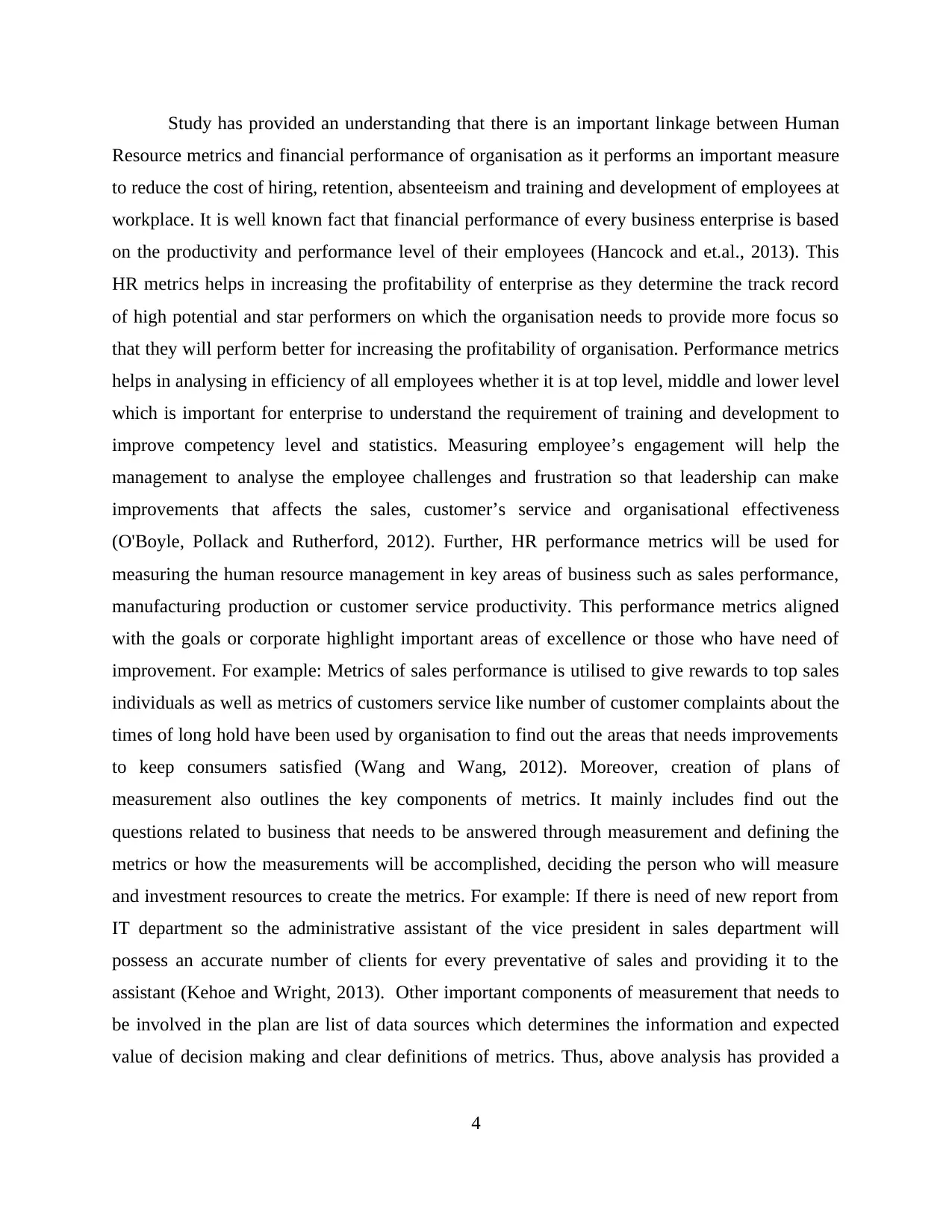
Study has provided an understanding that there is an important linkage between Human
Resource metrics and financial performance of organisation as it performs an important measure
to reduce the cost of hiring, retention, absenteeism and training and development of employees at
workplace. It is well known fact that financial performance of every business enterprise is based
on the productivity and performance level of their employees (Hancock and et.al., 2013). This
HR metrics helps in increasing the profitability of enterprise as they determine the track record
of high potential and star performers on which the organisation needs to provide more focus so
that they will perform better for increasing the profitability of organisation. Performance metrics
helps in analysing in efficiency of all employees whether it is at top level, middle and lower level
which is important for enterprise to understand the requirement of training and development to
improve competency level and statistics. Measuring employee’s engagement will help the
management to analyse the employee challenges and frustration so that leadership can make
improvements that affects the sales, customer’s service and organisational effectiveness
(O'Boyle, Pollack and Rutherford, 2012). Further, HR performance metrics will be used for
measuring the human resource management in key areas of business such as sales performance,
manufacturing production or customer service productivity. This performance metrics aligned
with the goals or corporate highlight important areas of excellence or those who have need of
improvement. For example: Metrics of sales performance is utilised to give rewards to top sales
individuals as well as metrics of customers service like number of customer complaints about the
times of long hold have been used by organisation to find out the areas that needs improvements
to keep consumers satisfied (Wang and Wang, 2012). Moreover, creation of plans of
measurement also outlines the key components of metrics. It mainly includes find out the
questions related to business that needs to be answered through measurement and defining the
metrics or how the measurements will be accomplished, deciding the person who will measure
and investment resources to create the metrics. For example: If there is need of new report from
IT department so the administrative assistant of the vice president in sales department will
possess an accurate number of clients for every preventative of sales and providing it to the
assistant (Kehoe and Wright, 2013). Other important components of measurement that needs to
be involved in the plan are list of data sources which determines the information and expected
value of decision making and clear definitions of metrics. Thus, above analysis has provided a
4
Resource metrics and financial performance of organisation as it performs an important measure
to reduce the cost of hiring, retention, absenteeism and training and development of employees at
workplace. It is well known fact that financial performance of every business enterprise is based
on the productivity and performance level of their employees (Hancock and et.al., 2013). This
HR metrics helps in increasing the profitability of enterprise as they determine the track record
of high potential and star performers on which the organisation needs to provide more focus so
that they will perform better for increasing the profitability of organisation. Performance metrics
helps in analysing in efficiency of all employees whether it is at top level, middle and lower level
which is important for enterprise to understand the requirement of training and development to
improve competency level and statistics. Measuring employee’s engagement will help the
management to analyse the employee challenges and frustration so that leadership can make
improvements that affects the sales, customer’s service and organisational effectiveness
(O'Boyle, Pollack and Rutherford, 2012). Further, HR performance metrics will be used for
measuring the human resource management in key areas of business such as sales performance,
manufacturing production or customer service productivity. This performance metrics aligned
with the goals or corporate highlight important areas of excellence or those who have need of
improvement. For example: Metrics of sales performance is utilised to give rewards to top sales
individuals as well as metrics of customers service like number of customer complaints about the
times of long hold have been used by organisation to find out the areas that needs improvements
to keep consumers satisfied (Wang and Wang, 2012). Moreover, creation of plans of
measurement also outlines the key components of metrics. It mainly includes find out the
questions related to business that needs to be answered through measurement and defining the
metrics or how the measurements will be accomplished, deciding the person who will measure
and investment resources to create the metrics. For example: If there is need of new report from
IT department so the administrative assistant of the vice president in sales department will
possess an accurate number of clients for every preventative of sales and providing it to the
assistant (Kehoe and Wright, 2013). Other important components of measurement that needs to
be involved in the plan are list of data sources which determines the information and expected
value of decision making and clear definitions of metrics. Thus, above analysis has provided a
4
⊘ This is a preview!⊘
Do you want full access?
Subscribe today to unlock all pages.

Trusted by 1+ million students worldwide
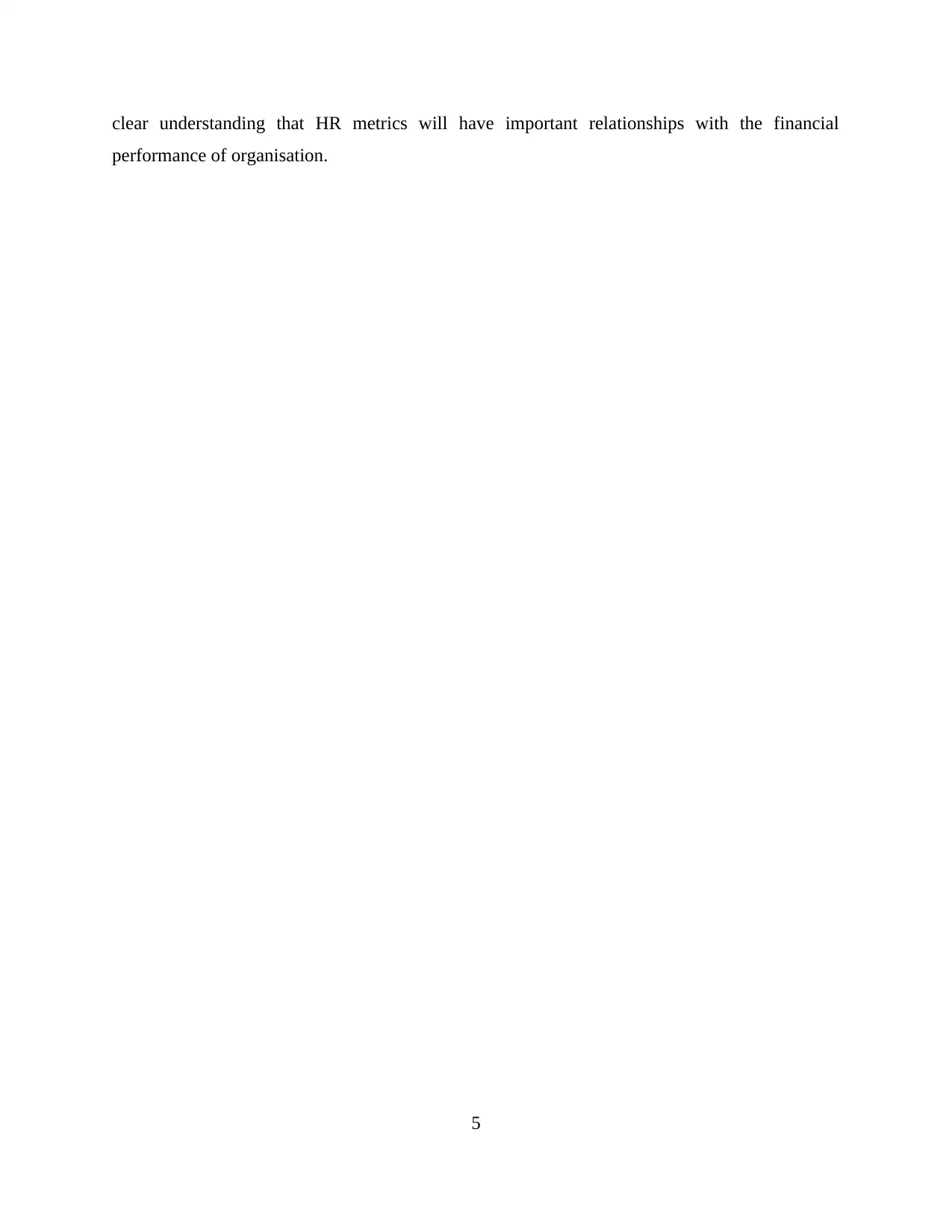
clear understanding that HR metrics will have important relationships with the financial
performance of organisation.
5
performance of organisation.
5
Paraphrase This Document
Need a fresh take? Get an instant paraphrase of this document with our AI Paraphraser
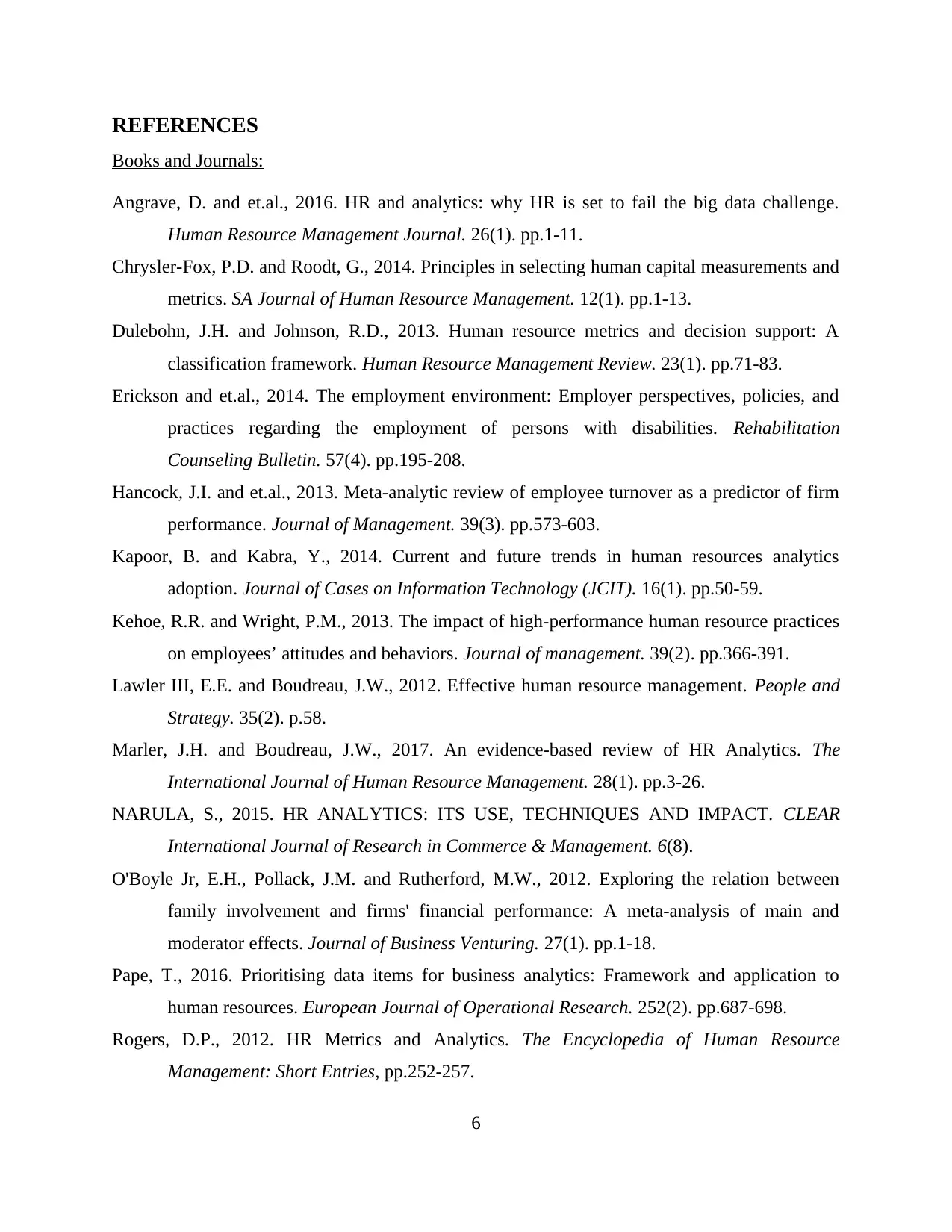
REFERENCES
Books and Journals:
Angrave, D. and et.al., 2016. HR and analytics: why HR is set to fail the big data challenge.
Human Resource Management Journal. 26(1). pp.1-11.
Chrysler-Fox, P.D. and Roodt, G., 2014. Principles in selecting human capital measurements and
metrics. SA Journal of Human Resource Management. 12(1). pp.1-13.
Dulebohn, J.H. and Johnson, R.D., 2013. Human resource metrics and decision support: A
classification framework. Human Resource Management Review. 23(1). pp.71-83.
Erickson and et.al., 2014. The employment environment: Employer perspectives, policies, and
practices regarding the employment of persons with disabilities. Rehabilitation
Counseling Bulletin. 57(4). pp.195-208.
Hancock, J.I. and et.al., 2013. Meta-analytic review of employee turnover as a predictor of firm
performance. Journal of Management. 39(3). pp.573-603.
Kapoor, B. and Kabra, Y., 2014. Current and future trends in human resources analytics
adoption. Journal of Cases on Information Technology (JCIT). 16(1). pp.50-59.
Kehoe, R.R. and Wright, P.M., 2013. The impact of high-performance human resource practices
on employees’ attitudes and behaviors. Journal of management. 39(2). pp.366-391.
Lawler III, E.E. and Boudreau, J.W., 2012. Effective human resource management. People and
Strategy. 35(2). p.58.
Marler, J.H. and Boudreau, J.W., 2017. An evidence-based review of HR Analytics. The
International Journal of Human Resource Management. 28(1). pp.3-26.
NARULA, S., 2015. HR ANALYTICS: ITS USE, TECHNIQUES AND IMPACT. CLEAR
International Journal of Research in Commerce & Management. 6(8).
O'Boyle Jr, E.H., Pollack, J.M. and Rutherford, M.W., 2012. Exploring the relation between
family involvement and firms' financial performance: A meta-analysis of main and
moderator effects. Journal of Business Venturing. 27(1). pp.1-18.
Pape, T., 2016. Prioritising data items for business analytics: Framework and application to
human resources. European Journal of Operational Research. 252(2). pp.687-698.
Rogers, D.P., 2012. HR Metrics and Analytics. The Encyclopedia of Human Resource
Management: Short Entries, pp.252-257.
6
Books and Journals:
Angrave, D. and et.al., 2016. HR and analytics: why HR is set to fail the big data challenge.
Human Resource Management Journal. 26(1). pp.1-11.
Chrysler-Fox, P.D. and Roodt, G., 2014. Principles in selecting human capital measurements and
metrics. SA Journal of Human Resource Management. 12(1). pp.1-13.
Dulebohn, J.H. and Johnson, R.D., 2013. Human resource metrics and decision support: A
classification framework. Human Resource Management Review. 23(1). pp.71-83.
Erickson and et.al., 2014. The employment environment: Employer perspectives, policies, and
practices regarding the employment of persons with disabilities. Rehabilitation
Counseling Bulletin. 57(4). pp.195-208.
Hancock, J.I. and et.al., 2013. Meta-analytic review of employee turnover as a predictor of firm
performance. Journal of Management. 39(3). pp.573-603.
Kapoor, B. and Kabra, Y., 2014. Current and future trends in human resources analytics
adoption. Journal of Cases on Information Technology (JCIT). 16(1). pp.50-59.
Kehoe, R.R. and Wright, P.M., 2013. The impact of high-performance human resource practices
on employees’ attitudes and behaviors. Journal of management. 39(2). pp.366-391.
Lawler III, E.E. and Boudreau, J.W., 2012. Effective human resource management. People and
Strategy. 35(2). p.58.
Marler, J.H. and Boudreau, J.W., 2017. An evidence-based review of HR Analytics. The
International Journal of Human Resource Management. 28(1). pp.3-26.
NARULA, S., 2015. HR ANALYTICS: ITS USE, TECHNIQUES AND IMPACT. CLEAR
International Journal of Research in Commerce & Management. 6(8).
O'Boyle Jr, E.H., Pollack, J.M. and Rutherford, M.W., 2012. Exploring the relation between
family involvement and firms' financial performance: A meta-analysis of main and
moderator effects. Journal of Business Venturing. 27(1). pp.1-18.
Pape, T., 2016. Prioritising data items for business analytics: Framework and application to
human resources. European Journal of Operational Research. 252(2). pp.687-698.
Rogers, D.P., 2012. HR Metrics and Analytics. The Encyclopedia of Human Resource
Management: Short Entries, pp.252-257.
6
1 out of 8
Related Documents
Your All-in-One AI-Powered Toolkit for Academic Success.
+13062052269
info@desklib.com
Available 24*7 on WhatsApp / Email
![[object Object]](/_next/static/media/star-bottom.7253800d.svg)
Unlock your academic potential
Copyright © 2020–2025 A2Z Services. All Rights Reserved. Developed and managed by ZUCOL.





